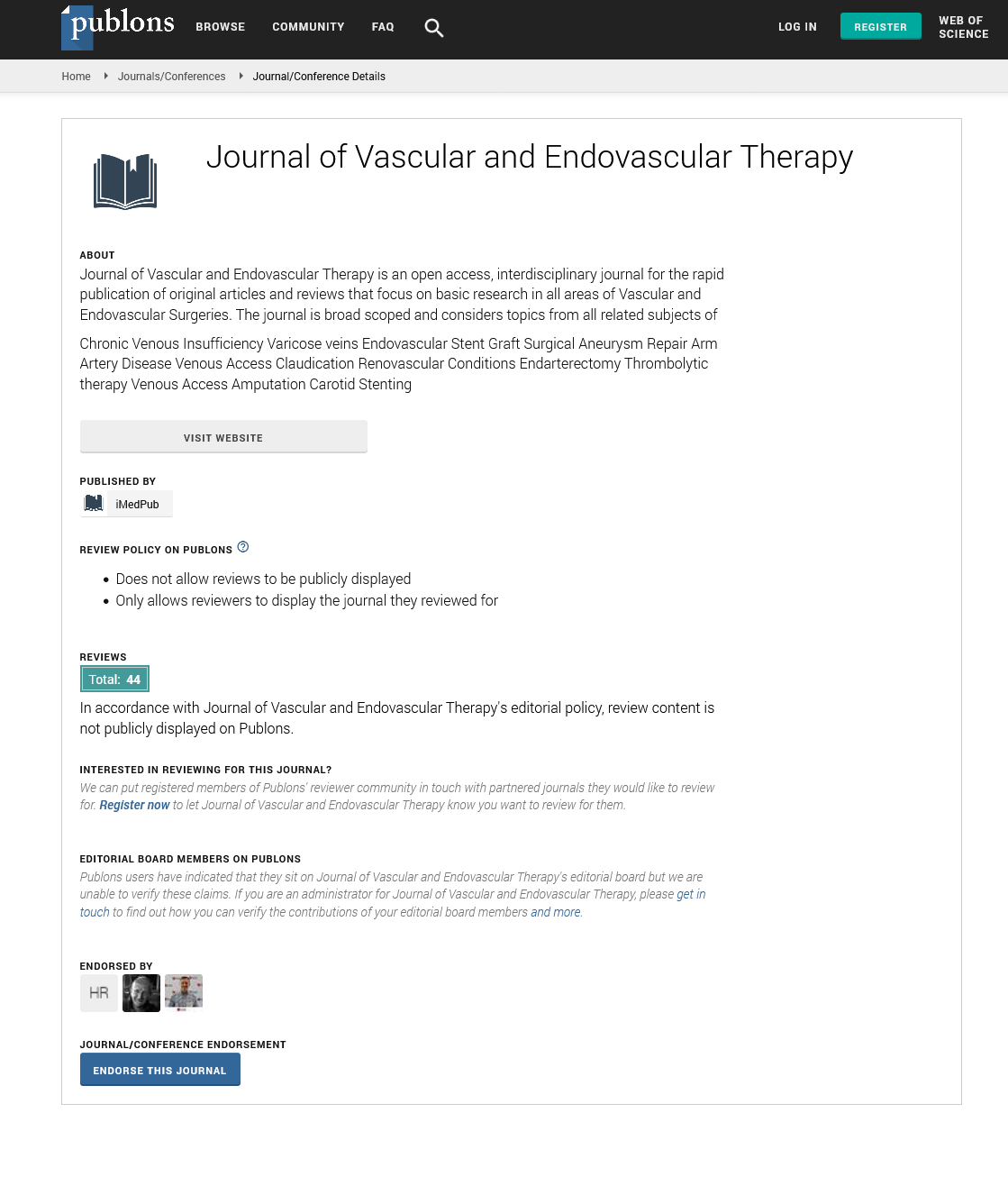ISSN : 2634-7156
Journal of Vascular and Endovascular Therapy
Insight into single nucleotide polymorphisms of Toll-like receptors and the risk of abdominal aortic aneurysm formation
3rd Edition of World Congress & Exhibition on Vascular Surgery
May 24-25, 2018 London, UK
Agnieszka Jablonska
Polish Academy of Sciences, Poland
ScientificTracks Abstracts: J Vasc Endovasc Therapy
DOI: 10.21767/2573-4482-C1-002
Abstract
Statement of the Problem: Toll-like receptors (TLRs) are a family of highly conserved, transmembrane proteins that recognize a wide spectrum of pathogen-associated molecular patterns (PAMPs) and activate innate immune response. It was recently shown that TLR2, TLR3, and TLR4 signaling contributes to abdominal aortic aneurysm (AAA) formation and development. However, there are no studies regarding the association between single nucleotide polymorphisms within TLR genes and the incidence of AAAs. The aim of this study was to determine the prevalence of TLR2, TLR3, and TLR4 polymorphisms, and investigate the relationship between these polymorphisms and AAA risk. Methodology & Theoretical Orientation: The presence of the seven TLR SNPs was studied using polymerase chain reactionrestriction fragment length polymorphism (PCR-RFLP), whereas a selected cytokine levels were quantified by enzyme-linked immunosorbent assays (ELISAs). Findings: The heterozygous genotype of the SNP rs121917864 of TLR2 was detected more frequently in patients with AAA and was associated with an almost six-fold increased risk of AAA (P<0.001) and larger aneurysm size (P=0.037). In contrast, a relationship between the heterozygous CA genotype of TLR3 SNP rs3775296 and diminished risk of AAA formation and development was found (P<0.001). Conclusion & Significance: The heterozygous genotype of TLR2 SNP rs121917864 may be a predictor of AAA formation, while TLR3 SNP rs3775296 seems to exert an independent protective effect. It is therefore essential to identify the host determinants of aneurysm formation in humans and understanding the role of the selected TLRs SNPs in the pathogenesis of AAA. Recent Publications 1. Lai C H, Wang K C, Lee F T, Tsai H W, Ma C Y, Cheng T L, Chang B I, Yang Y J, Shi G Y and Wu H L (2016) Toll-like receptor 4 is essential in the development of abdominal aortic aneurysm. PLoS One 11:e0146565. 2. Vorkapic E, Lyrundberg A M, Mäyränpää M I,
Eriksson P and Wågsäter D (2015) TRIF adaptor signaling is important in abdominal aortic aneurysm formation. Atherosclerosis 241:561-568. 3. Yan H, Cui B, Zhang X, Fu X, Yan J, Wang X, Lv X, Chen Z and Hu Z (2015) Antagonism of toll-like receptor 2 attenuates the formation and progression of abdominal aortic aneurysm. Acta Pharm Sin B 5:176187. 4. Aoyama N, Suzuki J, Ogawa M, Watanabe R, Kobayashi N, Hanatani T, Ashigaki N, Sekinishu A, Izumi Y and Isobe M (2013) Toll-like receptor-2 plays a fundamental role in periodontal bacteria-accelerated abdominal aortic aneurysms. Circ J 77:1565-1573. 5. Koch A, Pernow M, Barthuber C, Mersmann J, Zacharowski K and Grotemeyer D (2012) Systemic inflammation after aortic cross clamping is influenced by Toll-like receptor 2 preconditioning and deficiency. J Surg Res 178:833-841.
Biography
Agnieszka Jab√?¬?o√?¬?ska of the Institute of Medical Biology of the Polish Academy of Sciences has an experience in Molecular Virology. In her studies, she is aiming to understand the detailed molecular mechanism of viral infection and the host-pathogen interactions. Elucidation of biological significances of pattern-recognition receptors (PRRs) signaling pathways in which viruses are implicated is also one of her goals. Furthermore, she has tried to reveal the associations between the PRRs expression, single nucleotide polymorphism within TLR genes and the predisposition for abdominal aortic aneurysm development.
Email:ajablonska@cbm.pan.pl
Google Scholar citation report
Citations : 177
Journal of Vascular and Endovascular Therapy received 177 citations as per Google Scholar report
Journal of Vascular and Endovascular Therapy peer review process verified at publons
Abstracted/Indexed in
- Google Scholar
- Open J Gate
- Publons
- Geneva Foundation for Medical Education and Research
- Secret Search Engine Labs
Open Access Journals
- Aquaculture & Veterinary Science
- Chemistry & Chemical Sciences
- Clinical Sciences
- Engineering
- General Science
- Genetics & Molecular Biology
- Health Care & Nursing
- Immunology & Microbiology
- Materials Science
- Mathematics & Physics
- Medical Sciences
- Neurology & Psychiatry
- Oncology & Cancer Science
- Pharmaceutical Sciences
